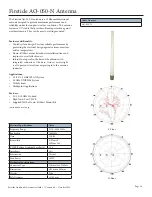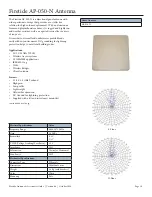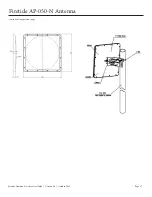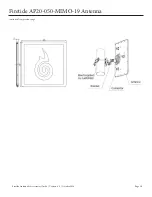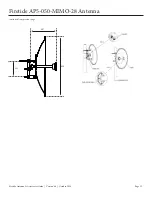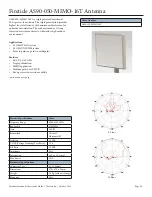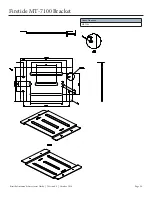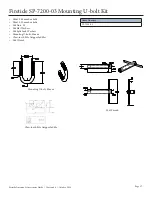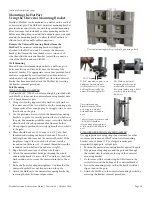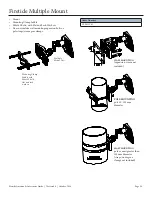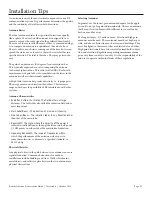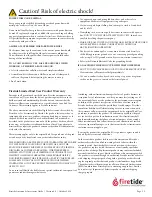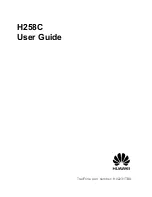
Page 28.
7020 Universal Mounting Bracket Install Guide
Planning Your Installation
Staging Considerations
Using the provided temporary staging antennas, set up and
test the HotPort nodes indoors, on a bench or table, before
mounting them onto an exterior wall or pole. Pre-configure
the nodes so that they are all on the same RF channel, etc. Use
HotView Pro to configure the HotPort nodes and create a
small mesh network. Test the network settings you plan to
use.
1. Check to see that all nodes are visible in HotView Pro. If
not, troubleshoot per directions in the HotView Reference
Guide.
2. Set the Country Code for your country of operation.
3. Re-verify that all nodes are visible, and verify that dual-
radio nodes have both radios correctly meshed.
Important!
The staging antennas provided with Firetide
outdoor HotPort nodes are for temporary use only. They
MUST be replaced with outdoor-rated antennas as soon as
the mesh is staged and operational. The staging antennas are
NOT waterproof and NOT moisture resistant. If used
outdoors, the antennas may fail.
Contact your Firetide Reseller for assistance in selecting
and ordering outdoor antennas suitable for your applications.
For reference, your Firetide CD has a copy of Firetide’s
Antenna & Accessory Guide.
Other Important Considerations
It is often easier to install all devices onto a pole,
•
and then attach the pole to the roof. In many cases,
connecting the devices to a pole already attached to the
roof top can be difficult and dangerous.
• A lightning surge suppressor MUST be used. Some
antennas include one, otherwise contact your Firetide
Reseller to order a suitable suppressor.
• Locate the HotPort close to the antenna; a short antenna
cable gives better performance than a longer one. Firetide
recommends antenna cables less than 3 meters.
The HotPort node and its antenna must both be grounded.
•
• Use non-vulcanized rubber weatherproofing kits to
weatherproof connectors and antennas.
Preparing Earth Ground
The HotPort node must be properly connected to earth
ground. Failure to do so may result in equipment
damage, injury, or death. The product warranty does not
cover damages resulting in part or in whole from
improper grounding. Consult your location’s building
and electrical codes regarding antennas and follow them,
or consult the National Electric Code (NEC).
• If connecting HotPort to a tower or pole, connect the
base of the tower pole directly to the building’s ground or
to one or more approved grounding rods using 10 AWG
ground wire and corrosion-resistant connectors.
• Connect the grounding cable to rain gutters only if the
rain gutter is properly connected to earth ground.
Ground rods should be copper, 1.8–2.4 m (6–8 ft) long.
•
• Install all grounding components in straight lines. If
bends are unavoidable, do not make sharp turns.
Earth-to-ground should not be more than 10 ohms.
•
Antenna Placement
Firetide recommends the use of antennas specifically designed
for MIMO applications. While it is possible to select and
mount six individual antennas, determining correct placement
and spacing is difficult. Use an antenna engineered for best
results with MIMO.
Mounting Bracket
HotPort node ships with a two-piece mounting bracket.
This bracket is of the same design as the HotPort 6202
outdoor bracket, so you can install a 7020 in place of a 6201
or 6202. The assembly is shown below.
The outer piece (the unversal mounting bracket) is secured
by tabs and four thumb screws to the inner bracket, as shown
below.
Thumb screw
Universal mounting bracket Thumb
screw
(attached by thumb screws
to the inner bracket)
The universal mounting bracket
is the outer of the two-piece
mounting bracket attached to
the back of the HotPort unit.
The universal mounting bracket
is secured by tabs and thumb
screws to the above shown inner
bracket.
Bottom view of a Firetide HotPort
continued on next page
Firetide Antenna & Accessories Guide | Version 4.0 | October 2014

